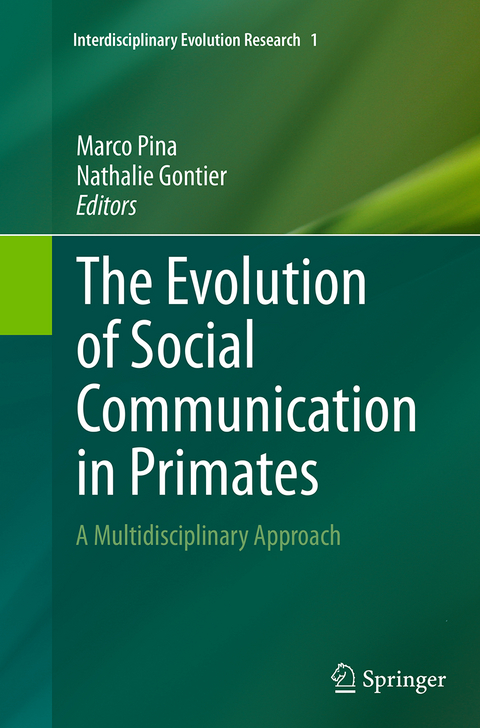
The Evolution of Social Communication in Primates
Springer International Publishing (Verlag)
978-3-319-34596-3 (ISBN)
Marco Pina has a background in medicine which he applies to topics in philosophy of biology and philosophy of medicine. He is currently preparing a doctoral dissertation on the development of the mind-brain dyad in the context of the nature/nurture debate, which is funded by the Portuguese Fund for Science and Technology and executed at the Faculty of Science of the Portuguese University of Lisbon. Previously, as a scientific collaborator for the Centre for Philosophy of Science of the University of Lisbon as well as its Applied Evolutionary Epistemology Lab, he has edited several books on evolutionary theory, language evolution, and the evolution of man.Nathalie Gontier is a philosopher of science and an anthropologist. Her main research interests lie in evolutionary epistemology and non-Darwinian evolutionary theories, how the latter differ from the Modern Synthesis and how they can be implemented into the linguistic sciences and the overall sociocultural domain. As the founding director of the Lisbon Applied Evolutionary Epistemology Lab, she is affiliated to the Centre for Philosophy of Science at the Faculty of Science of the University of Lisbon, and financed by the Portuguese Fund for Science and Technology. Previous appointments were held at the Dutch Free University of Brussels (Belgium), the Konrad Lorenz Institute (Austria), and the American Museum of Natural History (USA). Her research has been sponsored by the American John Templeton Foundation, the European Marie Curie Actions and the Belgian Fund for Scientific Research Flanders. She is the founder and editor-in-chief of the Springer book series Interdisciplinary Evolution Research.
Introduction.- PART I: Philosophical and Historical Roots of Social Communication Studies.- Lord Monboddo's Ourang Outang and the Origin and Progress of Language.- Ferality and Morality; The Politics of the "Forbidden Experiment" in the Twentieth Century.- PART II: The Elements of Social Communication in Primates and Humans.- Experimental Conversations: Sign Language Studies with Chimpanzees.- How Primate Mothers and Infants Communicate: Characterizing Interaction in Mother-Infant Studies.- On Prototypical Facial Expressions vs. Variation in Facial Behavior: What Have We Learned on the "Visibility" of Emotions from Measuring Facial Actions in Humans and Apes.- The Evolution of Joint Attention: A Review and Critique.- Describing Mental States: From Brain Science to a Science of Mind Reading.- PART III: Evolutionary Transitions from Social Communication Systems to Language.- Bodily Mimesis and the Transition to Speech.- From Grasping to Grooming to Gossip: Innovative Use of ChimpanzeeSignals in Novel Environments Supports both Vocal and Gestural Theories of Language Origins.- Reevaluating Chimpanzee Vocal Signals from the Ground Up.- PART IV: Evolutionary Origins of Human Language.- Communication and Human Uniqueness.- How did Humans Become Behaviorally Modern? Revisiting the 'Art First' Hypothesis.- Experiments and Simulations Can Inform Evolutionary Theories of the Cultural Evolution of Language.- The Emergence of Modern Communication in Primates: a Computational Approach.- What Can an Extended Synthesis do for Bio linguistics: On the Need and Benefits of the Eco-evo-devo Program.
"This volume provides a review of some of the many theoretical frameworks proposed to investigate the evolution of social communication in primates and in particular language in humans. ... a rich, thought-provoking, and multidisciplinary book that would appeal to any scholar interested in the origins and evolution of language and communication." (Roberta Salmi, The Quarterly Review of Biology, Vol. 90, September, 2015)
"This edited volume aims to provide a ... series of reviews and critiques of most currently available methodological and theoretical frameworks that guide research on the mechanisms and evolution of primate social communication and human language. ... Summing Up: Recommended. Graduate students and researchers/faculty." (J. B. Leca, Choice, Vol. 52 (6), February, 2015)| Erscheinungsdatum | 29.08.2016 |
|---|---|
| Reihe/Serie | Interdisciplinary Evolution Research |
| Zusatzinfo | X, 326 p. 18 illus., 11 illus. in color. |
| Verlagsort | Cham |
| Sprache | englisch |
| Maße | 155 x 235 mm |
| Themenwelt | Naturwissenschaften ► Biologie ► Evolution |
| Schlagworte | Behavioral Sciences • Behavioural theory (Behaviourism) • biological psychology • Biomedical and Life Sciences • Cognition and cognitive psychology • Cognitive linguistics • Cognitive Psychology • communicative behavior • Evolution • evolutionary biology • evolution of speech • Human Evolution • Mimesis • Philosophy of Language • Physiological and neuro-psychology, biopsychology • Theory of Mind • Zoology and animal sciences |
| ISBN-10 | 3-319-34596-6 / 3319345966 |
| ISBN-13 | 978-3-319-34596-3 / 9783319345963 |
| Zustand | Neuware |
| Haben Sie eine Frage zum Produkt? |
aus dem Bereich


